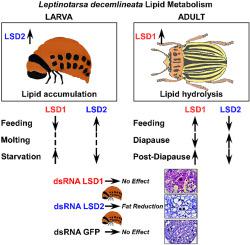Insect Biochemistry and Molecular Biology ( IF 3.2 ) Pub Date : 2020-09-30 , DOI: 10.1016/j.ibmb.2020.103473 Gözde Güney 1 , Umut Toprak 2 , Dwayne D Hegedus 3 , Şerife Bayram 2 , Cathy Coutu 3 , Diana Bekkaoui 3 , Doug Baldwin 3 , David G Heckel 4 , Sabine Hänniger 4 , Doğa Cedden 2 , Damla Amutkan Mutlu 5 , Zekiye Suludere 5

|
The Colorado potato beetle, Leptinotarsa decemlineata (Coleoptera: Chrysomelidae) inflicts serious damage to potato plants by feeding ravenously on their leaves. Adult L. decemlineata have a photoperiod-induced dormancy response, also known as diapause, which allows them to survive severe winter conditions by digging into soil. Most insects that undergo diapause accumulate abundant lipid reserves prior to diapause and utilize most of them during the diapause. This process is likely to be governed by the interplay of lipid storage droplet proteins (LSDs), also known as perilipins, with the help of other proteins. Here, genes encoding L. decemlineata LSD1 and LSD2 were identified. Both were expressed primarily in the fat body with LdLSD1 and LdLSD2 being primarily expressed in adult and larval stages, respectively. LdLSD1 was up-regulated in starving larvae, while LdLSD2 was primarily expressed in feeding larvae. The expression pattern of LdLSD1 in adults during feeding, diapause and post-diapause contrasted to the total body fat levels, while the expression pattern of LdLSD2 was positively correlated with total body fat levels. RNA interference (RNAi) of LdLSD2 in larvae suggested a core role for LSD2 in the protection/assembly of storage lipids as this treatment reduced overall lipid droplet volume. These data shed light on the functions of these proteins in L. decemlineata and their roles in both diapause and during starvation.
中文翻译:

从脂质储存液滴蛋白的角度看科罗拉多马铃薯甲虫的脂质代谢
科罗拉多马铃薯甲虫Leptinotarsa decemlineata(鞘翅目:Chrysomelidae)通过在马铃薯植物的叶子上贪婪地进食而对马铃薯植物造成严重损害。成年 L. decemlineata具有光周期诱导的休眠反应,也称为滞育,这使它们能够通过挖掘土壤在严酷的冬季条件下生存。大多数经历滞育的昆虫在滞育前积累了丰富的脂质储备,并在滞育期间利用其中的大部分。这一过程很可能受脂质储存液滴蛋白 (LSD)(也称为 perilipins)在其他蛋白质的帮助下的相互作用控制。在这里,鉴定了编码L. decemlineata LSD1 和 LSD2 的基因。两者都主要在具有LdLSD1的脂肪体中表达和LdLSD2分别主要在成虫和幼虫阶段表达。LdLSD1在饥饿的幼虫中上调,而LdLSD2主要在进食的幼虫中表达。的表达模式LdLSD1在成人中喂养,滞育和滞育后对比总身体脂肪水平,同时的表达模式LdLSD2呈正总身体脂肪水平相关。幼虫中LdLSD2 的RNA 干扰 (RNAi)表明 LSD2 在保护/组装储存脂质中的核心作用,因为这种处理减少了整体脂滴体积。这些数据阐明了这些蛋白质在L. decemlineata 中的功能 以及它们在滞育和饥饿期间的作用。











































 京公网安备 11010802027423号
京公网安备 11010802027423号